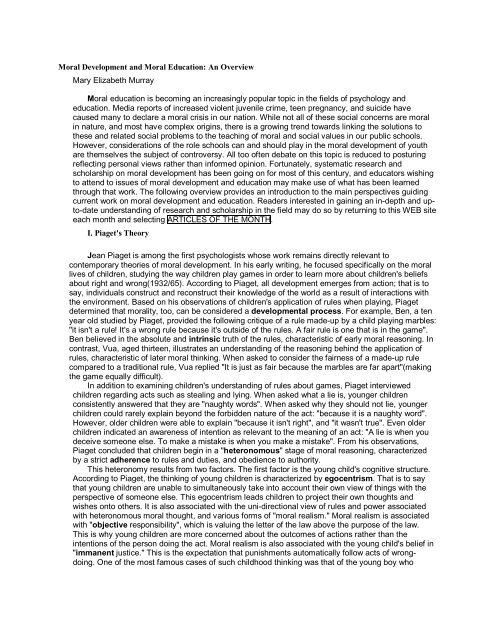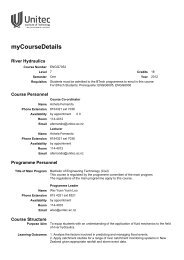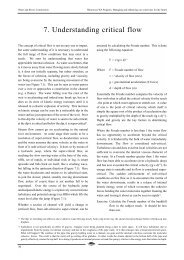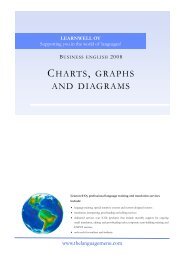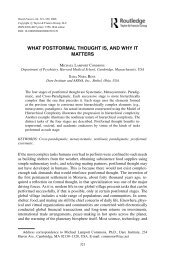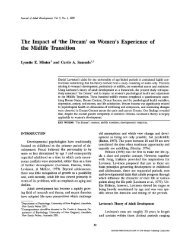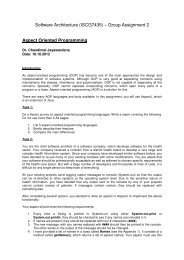Moral Development and Moral Education: An Overview
Moral Development and Moral Education: An Overview
Moral Development and Moral Education: An Overview
You also want an ePaper? Increase the reach of your titles
YUMPU automatically turns print PDFs into web optimized ePapers that Google loves.
<strong>Moral</strong> <strong>Development</strong> <strong>and</strong> <strong>Moral</strong> <strong>Education</strong>: <strong>An</strong> <strong>Overview</strong><br />
Mary Elizabeth Murray<br />
<strong>Moral</strong> education is becoming an increasingly popular topic in the fields of psychology <strong>and</strong><br />
education. Media reports of increased violent juvenile crime, teen pregnancy, <strong>and</strong> suicide have<br />
caused many to declare a moral crisis in our nation. While not all of these social concerns are moral<br />
in nature, <strong>and</strong> most have complex origins, there is a growing trend towards linking the solutions to<br />
these <strong>and</strong> related social problems to the teaching of moral <strong>and</strong> social values in our public schools.<br />
However, considerations of the role schools can <strong>and</strong> should play in the moral development of youth<br />
are themselves the subject of controversy. All too often debate on this topic is reduced to posturing<br />
reflecting personal views rather than informed opinion. Fortunately, systematic research <strong>and</strong><br />
scholarship on moral development has been going on for most of this century, <strong>and</strong> educators wishing<br />
to attend to issues of moral development <strong>and</strong> education may make use of what has been learned<br />
through that work. The following overview provides an introduction to the main perspectives guiding<br />
current work on moral development <strong>and</strong> education. Readers interested in gaining an in-depth <strong>and</strong> upto-date<br />
underst<strong>and</strong>ing of research <strong>and</strong> scholarship in the field may do so by returning to this WEB site<br />
each month <strong>and</strong> selecting ARTICLES OF THE MONTH.<br />
I. Piaget's Theory<br />
Jean Piaget is among the first psychologists whose work remains directly relevant to<br />
contemporary theories of moral development. In his early writing, he focused specifically on the moral<br />
lives of children, studying the way children play games in order to learn more about children's beliefs<br />
about right <strong>and</strong> wrong(1932/65). According to Piaget, all development emerges from action; that is to<br />
say, individuals construct <strong>and</strong> reconstruct their knowledge of the world as a result of interactions with<br />
the environment. Based on his observations of children's application of rules when playing, Piaget<br />
determined that morality, too, can be considered a developmental process. For example, Ben, a ten<br />
year old studied by Piaget, provided the following critique of a rule made-up by a child playing marbles:<br />
"it isn't a rule! It's a wrong rule because it's outside of the rules. A fair rule is one that is in the game".<br />
Ben believed in the absolute <strong>and</strong> intrinsic truth of the rules, characteristic of early moral reasoning. In<br />
contrast, Vua, aged thirteen, illustrates an underst<strong>and</strong>ing of the reasoning behind the application of<br />
rules, characteristic of later moral thinking. When asked to consider the fairness of a made-up rule<br />
compared to a traditional rule, Vua replied "It is just as fair because the marbles are far apart"(making<br />
the game equally difficult).<br />
In addition to examining children's underst<strong>and</strong>ing of rules about games, Piaget interviewed<br />
children regarding acts such as stealing <strong>and</strong> lying. When asked what a lie is, younger children<br />
consistently answered that they are "naughty words". When asked why they should not lie, younger<br />
children could rarely explain beyond the forbidden nature of the act: "because it is a naughty word".<br />
However, older children were able to explain "because it isn't right", <strong>and</strong> "it wasn't true". Even older<br />
children indicated an awareness of intention as relevant to the meaning of an act: "A lie is when you<br />
deceive someone else. To make a mistake is when you make a mistake". From his observations,<br />
Piaget concluded that children begin in a "heteronomous" stage of moral reasoning, characterized<br />
by a strict adherence to rules <strong>and</strong> duties, <strong>and</strong> obedience to authority.<br />
This heteronomy results from two factors. The first factor is the young child's cognitive structure.<br />
According to Piaget, the thinking of young children is characterized by egocentrism. That is to say<br />
that young children are unable to simultaneously take into account their own view of things with the<br />
perspective of someone else. This egocentrism leads children to project their own thoughts <strong>and</strong><br />
wishes onto others. It is also associated with the uni-directional view of rules <strong>and</strong> power associated<br />
with heteronomous moral thought, <strong>and</strong> various forms of "moral realism." <strong>Moral</strong> realism is associated<br />
with "objective responsibility", which is valuing the letter of the law above the purpose of the law.<br />
This is why young children are more concerned about the outcomes of actions rather than the<br />
intentions of the person doing the act. <strong>Moral</strong> realism is also associated with the young child's belief in<br />
"immanent justice." This is the expectation that punishments automatically follow acts of wrongdoing.<br />
One of the most famous cases of such childhood thinking was that of the young boy who
elieved that his hitting a power pole with his baseball bat caused a major power blackout in the New<br />
York city area.<br />
The second major contributor to heteronomous moral thinking in young children, is their relative<br />
social relationship with adults. In the natural authority relationship between adults <strong>and</strong> children, power<br />
is h<strong>and</strong>ed down from above. The relative powerlessness of young children, coupled with childhood<br />
egocentrism feeds into a heteronomous moral orientation.<br />
However, through interactions with other children in which the group seeks a to play together in a<br />
way all find fair, children find this strict heteronomous adherence to rules sometimes problematic. As<br />
children consider these situations, they develop towards an "autonomous" stage of moral reasoning,<br />
characterized by the ability to consider rules critically, <strong>and</strong> selectively apply these rules based on a<br />
goal of mutual respect <strong>and</strong> cooperation. The ability to act from a sense of reciprocity <strong>and</strong> mutual<br />
respect is associated with a shift in the child's cognitive structure from egocentrism to perspective<br />
taking. Coordinating one's own perspective with that of others means that what is right needs to be<br />
based on solutions that meet the requirements of fair reciprocity. Thus, Piaget viewed moral<br />
development as the result of interpersonal interactions through which individuals work out resolutions<br />
which all deem fair. Paradoxically, this autonomous view of morality as fairness is more compelling<br />
<strong>and</strong> leads to more consistent behavior than the heteronomous orientation held by younger children.<br />
Piaget concluded from this work that schools should emphasize cooperative decision-making <strong>and</strong><br />
problem solving, nurturing moral development by requiring students to work out common rules based<br />
on fairness. This is a direct rejection of sociologists Emile Durkheim's view of proper moral education<br />
(1925/1961). Durkheim, similar to Piaget, believed that morality resulted from social interaction or<br />
immersion in a group. However, Durkheim believed moral development was a natural result of<br />
attachment to the group, an attachment which manifests itself in a respect for the symbols, rules,<br />
<strong>and</strong> authority of that group. Piaget rejected this belief that children simply learn <strong>and</strong> internalize the<br />
norms for a group; he believed individuals define morality individually through their struggles to arrive<br />
at fair solutions. Given this view, Piaget suggested that a classroom teacher perform a difficult task:<br />
the educator must provide students with opportunities for personal discovery through problem solving,<br />
rather than indoctrinating students with norms.<br />
<strong>An</strong> excellent contemporary adaptation of Piaget's theory for moral development of young children<br />
may be found in DeVries, R. & Zan, B. (1994). "<strong>Moral</strong> Children: Constructing a Constructivist<br />
Atmosphere in Early <strong>Education</strong>." New York: Teachers College Press. You may preview some portions<br />
of that book within the FEATURED PRACTICES segment of this WEB site. DeVries <strong>and</strong> Zan go<br />
beyond Piaget's original work to include that of more recent theorists including Lawrence Kohlberg<br />
whose theory will be described next.<br />
II. Kohlberg's Theory of <strong>Moral</strong> <strong>Development</strong> <strong>and</strong> <strong>Education</strong><br />
<strong>Moral</strong> <strong>Development</strong><br />
Lawrence Kohlberg (1969) modified <strong>and</strong> elaborated Piaget's work, <strong>and</strong> laid the groundwork for<br />
the current debate within psychology on moral development. Consistent with Piaget, he proposed that<br />
children form ways of thinking through their experiences which include underst<strong>and</strong>ings of moral<br />
concepts such as justice, rights, equality <strong>and</strong> human welfare. Kohlberg followed the development of<br />
moral judgment beyond the ages studied by Piaget, <strong>and</strong> determined that the process of attaining<br />
moral maturity took longer <strong>and</strong> was more gradual than Piaget had proposed.<br />
On the basis of his research, Kohlberg identified six stages of moral reasoning grouped into three<br />
major levels. Each level represented a fundamental shift in the social-moral perspective of the<br />
individual. At the first level, the preconventional level, a person's moral judgments are characterized<br />
by a concrete, individual perspective. Within this level, a Stage 1 heteronomous orientation focuses<br />
on avoiding breaking rules that are backed by punishment, obedience for its own sake <strong>and</strong> avoiding<br />
the physical consequences of an action to persons <strong>and</strong> property. As in Piaget's framework, the<br />
reasoning of Stage 1 is characterized by ego-centrism <strong>and</strong> the inability to consider the perspectives of<br />
others. At Stage 2 there is the early emergence of moral reciprocity. The Stage 2 orientation focuses<br />
on the instrumental, pragmatic value of an action. Reciprocity is of the form, "you scratch my back<br />
<strong>and</strong> I'll scratch yours." The Golden Rule becomes, "If someone hits you, you hit them back." At Stage<br />
2 one follows the rules only when it is to someone's immediate interests. What is right is what's fair in<br />
the sense of an equal exchange, a deal, an agreement. At Stage 2 there is an underst<strong>and</strong>ing that
everybody has his(her) own interest to pursue <strong>and</strong> these conflict, so that right is relative (in the<br />
concrete individualist sense).<br />
Individuals at the conventional level of reasoning, however, have a basic underst<strong>and</strong>ing of<br />
conventional morality, <strong>and</strong> reason with an underst<strong>and</strong>ing that norms <strong>and</strong> conventions are necessary<br />
to uphold society. They tend to be self-identified with these rules, <strong>and</strong> uphold them consistently,<br />
viewing morality as acting in accordance with what society defines as right. Within this level,<br />
individuals at Stage 3 are aware of shared feelings, agreements, <strong>and</strong> expectations which take<br />
primacy over individual interests. Persons at Stage 3 define what is right in terms of what is expected<br />
by people close to one's self, <strong>and</strong> in terms of the stereotypic roles that define being good - e.g., a<br />
good brother, mother, teacher. Being good means keeping mutual relationships, such as trust, loyalty,<br />
respect, <strong>and</strong> gratitude. The perspective is that of the local community or family. There is not as yet a<br />
consideration of the generalized social system. Stage 4 marks the shift from defining what is right in<br />
terms of local norms <strong>and</strong> role expectations to defining right in terms of the laws <strong>and</strong> norms<br />
established by the larger social system. This is the "member of society" perspective in which one is<br />
moral by fulfilling the actual duties defining one's social responsibilities. One must obey the law<br />
except in extreme cases in which the law comes into conflict with other prescribed social duties.<br />
Obeying the law is seen as necessary in order to maintain the system of laws which protect everyone.<br />
Finally, the post conventional level is characterized by reasoning based on principles, using a<br />
"prior to society" perspective. These individuals reason based on the principles which underlie rules<br />
<strong>and</strong> norms, but reject a uniform application of a rule or norm. While two stages have been presented<br />
within the theory, only one, Stage 5, has received substantial empirical support. Stage 6 remains as<br />
a theoretical endpoint which rationally follows from the preceding 5 stages. In essence this last level<br />
of moral judgment entails reasoning rooted in the ethical fairness principles from which moral laws<br />
would be devised. Laws are evaluated in terms of their coherence with basic principles of fairness<br />
rather than upheld simply on the basis of their place within an existing social order. Thus, there is an<br />
underst<strong>and</strong>ing that elements of morality such as regard for life <strong>and</strong> human welfare transcend<br />
particular cultures <strong>and</strong> societies <strong>and</strong> are to be upheld irrespective of other conventions or normative<br />
obligations. These stages (1 -5) have been empirically supported by findings from longitudinal <strong>and</strong><br />
cross-cultural research (Power et al., 1989).<br />
III. <strong>Moral</strong> <strong>Education</strong><br />
Kohlberg used these findings to reject traditional character education practices. These<br />
approaches are premised in the idea that virtues <strong>and</strong> vices are the basis to moral behavior, or that<br />
moral character is comprised of a "bag of virtues", such as honesty, kindness, patience, strength, etc.<br />
According to the traditional approach, teachers are to teach these virtues through example <strong>and</strong> direct<br />
communication of convictions, by giving students an opportunity to practice these virtues, <strong>and</strong> by<br />
rewarding their expression. However, critiques of the traditional approach find flaws inherent in this<br />
model. This approach provides no guiding principle for defining what virtues are worthy of espousal,<br />
<strong>and</strong> wrongly assumes a community consensus on what are considered "positive values". In fact,<br />
teachers often end up arbitrarily imposing certain values depending upon their societal, cultural, <strong>and</strong><br />
personal beliefs. In order to address this issue of ethical relativity, some have adopted the valuesclarification<br />
approach to moral education. This teaching practice is based on the assumption that<br />
there are no single, correct answers to ethical dilemmas, but that there is value in holding clear views<br />
<strong>and</strong> acting accordingly. In addition, there is a value of toleration of divergent views. It follows, then,<br />
that the teacher's role is one of discussion moderator, with the goal of teaching merely that people<br />
hold different values; the teacher does attempt to present her views as the "right" views.<br />
Kohlberg rejected the focus on values <strong>and</strong> virtues, not only due to the lack of consensus on what<br />
virtues are to be taught, but also because of the complex nature of practicing such virtues. For<br />
example, people often make different decisions yet hold the same basic moral values. Kohlberg<br />
believed a better approach to affecting moral behavior should focus on stages of moral development.<br />
These stages are critical, as they consider the way a person organizes their underst<strong>and</strong>ing of virtues,<br />
rules, <strong>and</strong> norms, <strong>and</strong> integrates these into a moral choice (Power, Higgins, & Kohlberg, 1989). In<br />
addition, he rejected the relativist view point in favor of the view that certain principles of justice <strong>and</strong><br />
fairness represent the pinnacle of moral maturity, as he found that these basic moral principles are<br />
found in different cultures <strong>and</strong> subcultures around the world (Kohlberg & Turiel, 1971).
The goal of moral education, it then follows, is to encourage individuals to develop to the next<br />
stage of moral reasoning. Initial educational efforts employing Kohlberg's theory were grounded in<br />
basic Piagetian assumptions of cognitive development. <strong>Development</strong>, in this model, is not merely the<br />
result of gaining more knowledge, but rather consists of a sequence of qualitative changes in the<br />
way an individual thinks. Within any stage of development, thought is organized according to the<br />
constraints of that stage. <strong>An</strong> individual then interacts with the environment according to their basic<br />
underst<strong>and</strong>ings of the environment. However, the child will at some point encounter information which<br />
does not fit into their world view, forcing the child to adjust their view to accommodate this new<br />
information. This process is called equilibration, <strong>and</strong> it is through equilibration that development<br />
occurs. Early moral development approaches to education, therefore, sought to force students to<br />
ponder contradiction inherent to their present level of moral reasoning.<br />
The most common tool for doing this was to present a "moral dilemma" (see the FEATURED<br />
PRACTICES segment on this web site) <strong>and</strong> require students to determine <strong>and</strong> justify what course the<br />
actor in the dilemma should take. Through discussion, students should then be forced to face the<br />
contradictions present in any course of action not based on principles of justice or fairness.<br />
While Kohlberg appreciated the importance <strong>and</strong> value of such moral dilemma discussions, he<br />
held from very early on that moral education required more than individual reflection, but also needed<br />
to include experiences for students to operate as moral agents within a community. In this regard,<br />
Kohlberg reconciled some of the differences in orientation that existed between the theories of moral<br />
growth held by Piaget <strong>and</strong> Durkheim. In order to provide students with an optimal context within which<br />
to grow morally, Kohlberg <strong>and</strong> his colleagues developed the "just community" schools approach<br />
towards promoting moral development (Power, Higgins, & Kohlberg, 1989). The basic premise of<br />
these schools is to enhance students' moral development by offering them the chance to participate<br />
in a democratic community. Here, democracy refers to more than simply casting a vote. It entails full<br />
participation of community members in arriving at consensual rather than "majority rules" decisionmaking.<br />
One primary feature of these schools is their relatively small size (often they are actually<br />
schools within schools), aimed at providing the students with a sense of belonging to a group which is<br />
responsive to individual needs. The central institution of these schools is a community meeting in<br />
which issues related to life <strong>and</strong> discipline in the schools are discussed <strong>and</strong> democratically decided,<br />
with an equal value placed on the voices of students <strong>and</strong> teachers. <strong>An</strong> underlying goal of these<br />
meetings is to establish collective norms which express fairness for all members of the community. It<br />
is believed that by placing the responsibility of determining <strong>and</strong> enforcing rules on students, they will<br />
take prosocial behavior more seriously. At the same time, this approach stems from the cognitivedevelopmentalist<br />
view that discussion of moral dilemmas can stimulate moral development.<br />
However, this is not to say that just community school simply leaves students to their own<br />
devices; teachers play a crucial leadership role in these discussions, promoting rules <strong>and</strong> norms<br />
which have a concern for justice <strong>and</strong> community, <strong>and</strong> ultimately enforcing the rules. This role is not an<br />
easy one, as teachers must listen closely <strong>and</strong> underst<strong>and</strong> a student's reasoning, in order to help the<br />
student to the next level of reasoning. This requires a delicate balance between letting the students<br />
make decisions, <strong>and</strong> advocating in a way which shows them the limits in their reasoning. A primary<br />
advantage to the Just Community approach is its effectiveness in affecting students actions, not just<br />
their reasoning. Students are, in effect, expected to "practice what they preach", by following the rules<br />
determined in community meetings.<br />
The most comprehensive <strong>and</strong> authoritative source for work on Kohlberg's approach to moral<br />
education is to be found in : Power, F. C., Higgins, A., & Kohlberg, L. (1989). "Lawrence Kohlberg's<br />
Approach to <strong>Moral</strong> <strong>Education</strong>." New York: Columbia University Press.<br />
IV. Domain Theory: Distinguishing <strong>Moral</strong>ity <strong>and</strong> Convention<br />
In the early 1970s, longitudinal studies conducted by the Kohlberg research group began to<br />
reveal anomalies in the stage sequence. Researchers committed to the basic Kohlberg<br />
framework attempted to resolve those anomalies through adjustments in the stage descriptions (see<br />
the Power, Higgins, & Kohlberg, 1989 reference for an account of those changes). Other theorists,<br />
however, found that a comprehensive resolution to the anomalous data required substantial<br />
adjustments in the theory itself. One of the most productive lines of research to come out of that<br />
period has been the domain theory advanced by Elliot Turiel <strong>and</strong> his colleagues.
Within domain theory a distinction is drawn between the child's developing concepts of morality,<br />
<strong>and</strong> other domains of social knowledge, such as social convention. According to domain theory, the<br />
child's concepts of morality <strong>and</strong> social convention emerge out of the child's attempts to account for<br />
qualitatively differing forms of social experience associated with these two classes of social events.<br />
Actions within the moral domain, such as unprovoked hitting of someone, have intrinsic effects (i.e.,<br />
the harm that is caused) on the welfare of another person. Such intrinsic effects occur irregardless of<br />
the nature of social rules that may or may not be in place regarding the action. Because of this, the<br />
core features of moral cognition are centered around considerations of the effects which actions have<br />
upon the well-being of persons. <strong>Moral</strong>ity is structured by concepts of harm, welfare, <strong>and</strong> fairness.<br />
In contrast, actions that are matters of social convention have no intrinsic interpersonal<br />
consequences. For example, there is nothing intrinsic to the forms of address we employ that makes<br />
calling a college teacher "professor" better or worse than calling the person Mr. or Ms., or simply<br />
using their given names. What makes one form of address better than another is the existence of<br />
socially agreed upon rules. These conventions, while arbitrary in the sense that they have no<br />
intrinsic status, are nonetheless important to the smooth functioning of any social group. Conventions<br />
provide a way for members of the group to coordinate their social exchanges through a set of agreed<br />
upon <strong>and</strong> predictable modes of conduct. Concepts of convention then, are structured by the child's<br />
underst<strong>and</strong>ings of social organization.<br />
These hypothesized distinctions have been sustained through studies over the past 20 years.<br />
These studies have included interviews with children, adolescents <strong>and</strong> adults; observations of childchild<br />
<strong>and</strong> adult-child social interactions; cross-cultural studies; <strong>and</strong> longitudinal studies examining the<br />
changes in children's thinking as they grow older. <strong>An</strong> example of the distinction between morality <strong>and</strong><br />
convention is given in the following excerpt from an interview with a four-year-old girl regarding her<br />
perceptions of spontaneously occurring transgressions at her preschool.<br />
MORAL ISSUE: Did you see what happened? Yes. They were playing <strong>and</strong> John hit him too hard.<br />
Is that something you are supposed to do or not supposed to do? Not so hard to hurt. Is there a rule<br />
about that? Yes. What is the rule? You're not to hit hard. What if there were no rule about hitting hard,<br />
would it be all right to do then? No. Why not? Because he could get hurt <strong>and</strong> start to cry.<br />
CONVENTIONAL ISSUE: Did you see what just happened? Yes. They were noisy. Is that<br />
something you are supposed to or not supposed to do? Not do. Is there a rule about that? Yes. We<br />
have to be quiet. What if there were no rule, would it be all right to do then? Yes. Why? Because<br />
there is no rule.<br />
<strong>Moral</strong>ity <strong>and</strong> convention, then, are distinct, parallel developmental frameworks, rather than a<br />
single system as thought of by Kohlberg. However, because all social events, including moral ones,<br />
take place within the context of the larger society, a person's reasoning about the right course of<br />
action in any given social situation may require the person to access <strong>and</strong> coordinate their<br />
underst<strong>and</strong>ings from more than one of these two social cognitive frameworks. For, example, whether<br />
people line up to buy movie theater tickets is largely a matter of social convention. <strong>An</strong>yone who has<br />
traveled outside of Northern Europe or North America can attest to the fact that lining up is not a<br />
shared social norm across cultures. Within the United States or Engl<strong>and</strong>, for example, lining up is the<br />
conventional way in which turn-taking is established. The act of turn-taking has a moral consequence.<br />
It establishes a mechanism for sharing - an aspect of distributive justice. The act of breaking in line<br />
within the American or British context is more than merely a violation of convention. It is a violation of<br />
a basic set of rules that people hold to maintain fairness. How people coordinate the possible<br />
interactions that may arise between issues of morality <strong>and</strong> convention is a function of several factors<br />
including: the salience of the features of the act (what seems most important - the moral or<br />
conventional elements); <strong>and</strong> the developmental level of the person (adolescents for example view<br />
conventions as unimportant <strong>and</strong> arbitrary norms established by adult authority).<br />
It was Turiel's insight to recognize that what Kohlberg's theory attempts to account for within a<br />
single developmental framework is in fact the set of age-related efforts people make at different<br />
points in development to coordinate their social normative underst<strong>and</strong>ings from several different<br />
domains. Thus, domain theory posits a great deal more inconsistency in the judgments of individuals<br />
across contexts, <strong>and</strong> allows for a great deal more likelihood of morally (fairness <strong>and</strong> welfare) based<br />
decisions from younger <strong>and</strong> less developed people than would be expected from within the traditional<br />
Kohlberg paradigm.
Current work from within domain theory has sought to explore how the child's concepts of moral<br />
<strong>and</strong> conventional regulation relate to their developing underst<strong>and</strong>ings of personal prerogative <strong>and</strong><br />
privacy. This work is exploring how children develop their concepts of autonomy <strong>and</strong> its relation to<br />
social authority. This has led to a fruitful series of studies of adolescent-parent conflict with important<br />
implications for ways in which parents may contribute to the healthy development of youth (Smetana,<br />
1996). This work is also being extended into studies of how adolescents perceive the authority of<br />
teachers <strong>and</strong> school rules.<br />
V. <strong>Moral</strong> <strong>and</strong> Social Values <strong>Education</strong><br />
The implications of domain theory for values education are several. First, the identification of a<br />
domain of moral cognition that is tied to the inherent features of human social interaction means that<br />
moral education may be grounded in universal concerns for fairness <strong>and</strong> human welfare, <strong>and</strong> is not<br />
limited to the particular conventions or norms of a given community or school district. By focusing on<br />
those universal features of human moral underst<strong>and</strong>ing, public schools may engage in fostering<br />
children's morality without being accused of promoting a particular religion, <strong>and</strong> without undercutting<br />
the basic moral core of all major religious systems.<br />
Second, educational research from within domain theory has resulted in a set of<br />
recommendations for what is termed "domain appropriate" values education. This approach entails<br />
the teacher's analysis <strong>and</strong> identification of the moral or conventional nature of social values issues to<br />
be employed in values lessons. Such an analysis contributes to the likelihood that the issues<br />
discussed are concordant with the domain of the values dimension they are intended to affect. A<br />
discussion of dress codes, for example, would constitute a poor basis for moral discussion, since<br />
mode of dress is primarily a matter of convention. Likewise, consideration of whether it is right to steal<br />
to help a person in need, would be a poor issue with which to generate a lesson intended to foster<br />
students' underst<strong>and</strong>ings of social conventions. A related function of the teacher would be to focus<br />
student activity (verbal or written) on the underlying features concordant with the domain of the issue.<br />
Thus, students dealing with a moral issue would be directed to focus on the underlying justice or<br />
human welfare considerations of the episode. With respect to conventions, the focus of student<br />
activity would be on the role of social expectations <strong>and</strong> the social organizational functions of such<br />
social norms.<br />
On the basis of this kind of analysis teachers are also better enabled to lead students through<br />
consideration of more complex issues which contain elements from more than one domain. By being<br />
aware of the developmental changes that occur in students' comprehension of the role of social<br />
convention, <strong>and</strong> related changes in students underst<strong>and</strong>ing of what it means to be fair or considerate<br />
of the welfare of others, teachers are able to frame consideration of complex social issues in ways<br />
that will maximize the ability of students to comprehend <strong>and</strong> act upon the moral <strong>and</strong> social meaning of<br />
particular courses of action.<br />
The best sources for discussion of domain appropriate education, along with guidelines <strong>and</strong><br />
examples for how teachers may select materials from existing school curricula from which to generate<br />
lessons <strong>and</strong> practices which will foster students' development within both the moral <strong>and</strong> conventional<br />
domains may be found in: Nucci, L. & Weber, E. (1991) "The domain approach to values education:<br />
From theory to practice" In W. Kurtines & J. Gewirtz (Eds.) "H<strong>and</strong>book of <strong>Moral</strong> Behavior <strong>and</strong><br />
<strong>Development</strong> (Volume 3: Applications)pp. 251 - 266). <strong>and</strong> also in: Nucci, L. (1989) "Challenging<br />
Conventional Wisdom About <strong>Moral</strong>ity: The Domain Approach to Values <strong>Education</strong>." In L. Nucci (Ed.)<br />
"<strong>Moral</strong> <strong>Development</strong> <strong>and</strong> Character <strong>Education</strong>: A Dialogue" Berkeley: McCutchan.<br />
Examples of such materials <strong>and</strong> practices will be provided in coming months on the FEATURED<br />
PRACTICES segment of this WEB site.<br />
VI. Carol Gilligan <strong>and</strong> the <strong>Moral</strong>ity of Care<br />
A second major critique of Kohlberg's work was put forth by Carol Gilligan, in her popular<br />
book, "In a Different Voice: Psychological Theory <strong>and</strong> Women's <strong>Development</strong>" (1982). She<br />
suggested that Kohlberg's theories were biased against women, as only males were used in his<br />
studies. By listening to women's experiences, Gilligan offered that a morality of care can serve in the<br />
place of the morality of justice <strong>and</strong> rights espoused by Kohlberg. In her view, the morality of caring<br />
<strong>and</strong> responsibility is premised in nonviolence, while the morality of justice <strong>and</strong> rights is based on
equality. <strong>An</strong>other way to look at these differences is to view these two moralities as providing two<br />
distinct injunctions - the injunction not to treat others unfairly (justice) <strong>and</strong> the injunction not to turn<br />
away from someone in need (care). She presents these moralities as distinct, although potentially<br />
connected.<br />
In her initial work, Gilligan emphasized the gender differences thought to be associated with<br />
these two orientations. The morality of care emphasizes interconnectedness <strong>and</strong> presumably<br />
emerges to a greater degree in girls owing to their early connection in identity formation with their<br />
mothers. The morality of justice, on the other h<strong>and</strong>, is said to emerge within the context of<br />
coordinating the interactions of autonomous individuals. A moral orientation based on justice was<br />
proposed as more prevalent among boys because their attachment relations with the mother, <strong>and</strong><br />
subsequent masculine identity formation entailed that boys separate from that relationship <strong>and</strong><br />
individuate from the mother. For boys, this separation also heightens their awareness of the<br />
difference in power relations between themselves <strong>and</strong> the adult, <strong>and</strong> hence engenders an intense<br />
set of concerns over inequalities. Girls, however, because of their continued attachment to their<br />
mothers, are not as keenly aware of such inequalities, <strong>and</strong> are, hence, less concerned with fairness<br />
as an issue. Further research has suggested, however, that moral reasoning does not follow the<br />
distinct gender lines which Gilligan originally reported. The preponderance of evidence is that both<br />
males <strong>and</strong> females reason based on justice <strong>and</strong> care. While this gender debate is unsettled, Gilligan's<br />
work has contributed to an increased awareness that care is an integral component of moral<br />
reasoning.<br />
<strong>Education</strong>al approaches based on Gilligan's work have emphasized efforts to foster empathy<br />
<strong>and</strong> care responses in students. Perhaps the most comprehensive treatment of these issues may be<br />
found in Nel Noddings book, "The challenge to care in schools" New York: Teachers College Press,<br />
1992.<br />
VII. Conclusion<br />
This segment was designed to provide an overview of the major developmental theories currently<br />
influencing research on moral education. To remain current with new information <strong>and</strong> approaches in<br />
this very active field you should check this WEB site on a regular basis for ARTICLES OF THE<br />
MONTH. To learn about available books in the field check the RECENT BOOKS segment (currently<br />
under construction). For persons wanting to learn more about traditional character education please<br />
check the RELATED WEB SITES icon.<br />
This overview was prepared by Mary Elizabeth Murray, Department of Psychology, University if<br />
Illinois at Chicago. Comments or inquiries for further information should be directed to PROFESSOR<br />
LARRY NUCCI, University of Illinois at Chicago.<br />
Selected References<br />
Gilligan, C. (1982). In a different voice: Psychological theory <strong>and</strong> women's development. Harvard<br />
University Press: Cambridge.<br />
Kohlberg, L. & Turiel, E. (1971). <strong>Moral</strong> development <strong>and</strong> moral education. In G. Lesser, ed.<br />
Psychology <strong>and</strong> educational practice. Scott Foresman.<br />
Piaget, J. (1965). The moral judgment of the child. The Free Press: New York. Power, F. C., Higgins,<br />
A., & Kohlberg, L. (1989). "Lawrence Kohlberg's Approach to <strong>Moral</strong> <strong>Education</strong>." New York:<br />
Columbia University Press.<br />
Smetana, J. G. (1996, in press). "Parenting <strong>and</strong> the development of social<br />
knowledgereconceptualized: A social domain analysis." To appear in J.E. Grusec &<br />
L.Kuczynski (Eds.), H<strong>and</strong>book of parenting <strong>and</strong> the transmission of values. NewYork: Wiley.<br />
Turiel, E. (1983). "The <strong>Development</strong> of Social Knowledge: <strong>Moral</strong>ity & Convention." New York:<br />
Cambridge University Press.


